On Squinting
I wanted to write a bit about the mechanics of painting; but even with the mechanics (or how-to’s), the purpose remains the same: in the exercise of our natural powers, we grow more powerful and are fulfilled. That is the source of the pleasure that drives the process. And it is the process that creates the work.
Let’s talk about how squinting helps us, strange as it may seem, to actually see in a way that enables us to become better painters. By squinting I mean the narrowing of our eyelids so that less light enters our eyes and so that we are unable to focus. Now, here’s the rule: when we look at our subject we squint – always, without exception. I think I can demonstrate why squinting is a necessary and essential part of the process with a few examples. Let’s begin with what is called the “checker shadow illusion.”*
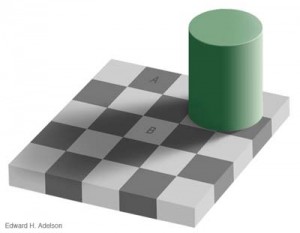
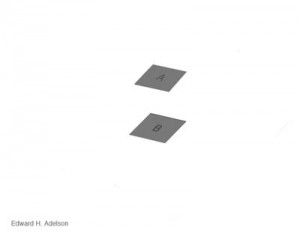
Take a look at the image on the left: you see a checkerboard upon which a cylinder casts a shadow. You will also see two squares, A and B. As it turns out both A and B are identical. They have the same value (that is the same level of lightness or darkness). Now if one looks at the image on the left, square A and B seem to be of different values (A looks darker than B). But when we isolate squares A and B on the right – without the checkerboard or the cylinder or shadow, we can see easily that they are the same value. So what is going on?
Well, the reason for the “optical illusion” is that square A is surrounded by light squares and thus seems darker. Square B is not only surrounded by darker squares, it is surrounded by darker squares which have a shadow cast over them – thus they are very dark compared to square B. Therefore, when we look casually at the checkerboard, square A seems relatively dark, whereas square B seems relatively light.
The key word here is relatively and the key concept to introduce at this point is called relations. In every single painting, assuming we wish to create a sense of space and that we are painting from nature, we want the values to be properly related; that is, we would like dark things to actually be darker than light things. So here’s the way to do this: SQUINT and compare. Because we cannot focus when we squint, it is far easier to see the whole thing and compare the values.
Go back to the checkerboard and squint way, way down. All the squares in the shadow become a blur. They are all darkish – very similar in value to square A. So by squinting, we are able to relate the values properly. Now let us take a real world example.
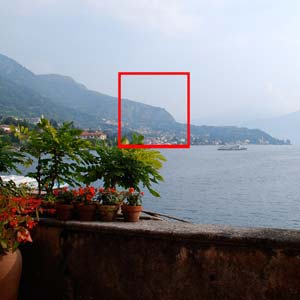
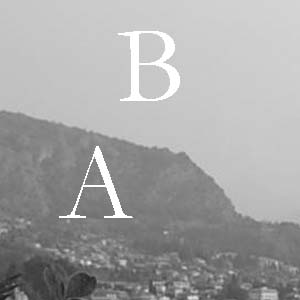
Let’s say we wish to paint the view above on the left. Notice what is inside the red square: a darkish mountain against a lightish sky. Here is where squinting will help us.
If we are not careful we will make the mountain too dark. Just as in the case of square A above, the mountain will look darker than it is because it is next to something much lighter. You can see this value relationship in the image on the right. I have cropped out that square and made it black and white so we can better judge values. The mountain area A is significantly darker than sky area B.
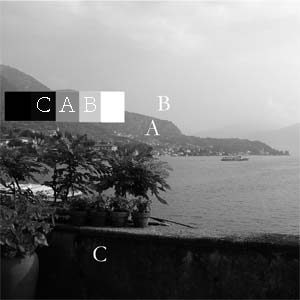
But if we squint, it becomes apparent that mountain area A, while darker than sky area B, is still significantly lighter than the wall area C. If we didn’t squint, it would be difficult to get this relationship. To see these relationships better, I have inserted a row of blocks into the photo above, each with a different value. On the left side is pure black and on the right is pure white. Notice that area C is nearly black while area A (the mountain) is much lighter. And perhaps surprisingly area B, the sky, isn’t close to white at all.
So it is necessary to squint at all times. Squinting also helps us to relate colors as well. When we see the relationship of values and colors properly, we are in a better position to see the whole and to feel the whole: the harmony as well as the notes of darks and lights that push things toward balance or imbalance, that give the thing movement or not.
Don’t play the notes, play the music – of course. But in order to play the music we must first master the notes and squinting helps us do that.
* If you would like to see the checkerboard optical illusion and an attendant explanation, go here:
http://web.mit.edu/persci/people/adelson/checkershadow_illusion.html
4 Comments
Address
Via Teresio Olivelli, 20
22021 Bellagio (CO)
Italy
+39 338 975 7135
Open Hours
Tuesday - Saturday: 11:00am – 6:00pm
Sunday - Monday: 1:00pm – 6:00pm

Great post, I was not squinting nearly enough.
What is the origin of this technique?
I don’t know about the origin, but it is absolutely essential. The technique goes back at least to the 17th century with Claude Lorrain (google him or “Claude Glass.”)
One way of understanding what one must see when one squints is to look into a black piece of paper covered by a normal pain of glass. The glass must be held in
such a way so that one can see the subject matter being painted (one kind of looks backwards over one’s shoulder). When one looks into such a glass, much of the
information is eliminated so it has the effect of squinting and it is very easy, then, to see value relationships (and where values separate; ie, lines). Given all of this,
the practice is at least 300 years old.
Very clear and concise posts that helps us understand WHY what we’ve been told all these years is “spot on”.
Thanks!!
This is one of the best articles I’ve read on this topic, Jerry. Much appreciated.